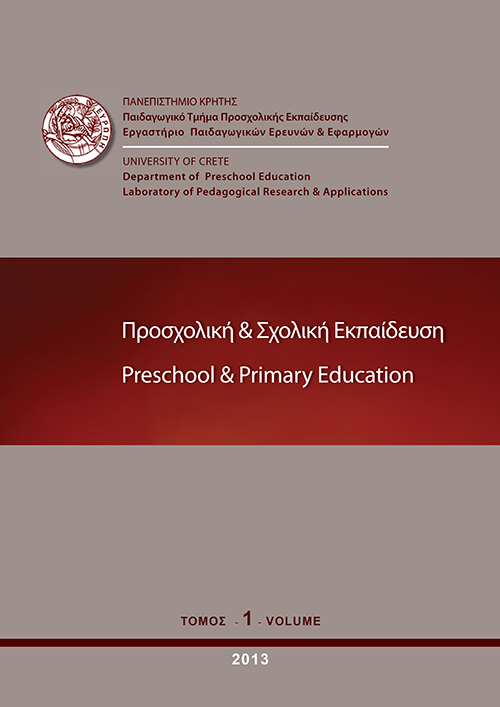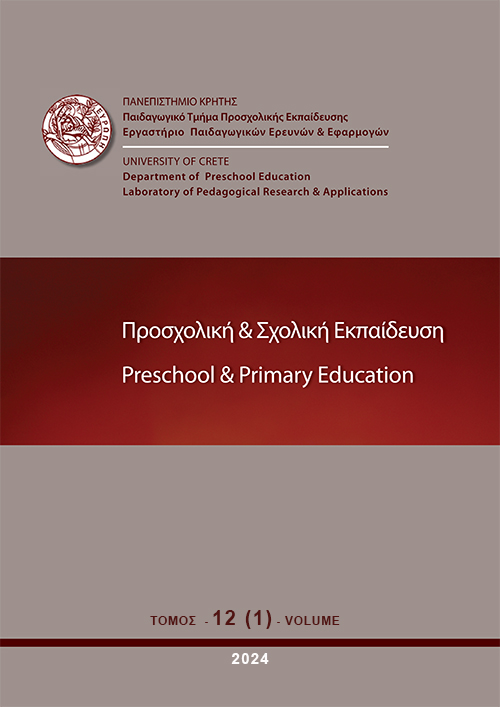Κυβερνο-εκφοβισμός και κυβερνο-θυματοποίηση σε παιδιά και εφήβους: Συχνότητα εμφάνισης και παράγοντες επικινδυνότητας
Abstract
Article Details
- Zitationsvorschlag
-
Kokkinos, C. M., & Antoniadou, N. (2013). Κυβερνο-εκφοβισμός και κυβερνο-θυματοποίηση σε παιδιά και εφήβους: Συχνότητα εμφάνισης και παράγοντες επικινδυνότητας. Preschool and Primary Education, 1, 138–169. https://doi.org/10.12681/ppej.42
- Ausgabe
- Bd. 1 (2013)
- Rubrik
- Άρθρα
Οι συγγραφείς των άρθρων που δημοσιεύονται στο ΠΡΟΣΧΟΛΙΚΗ & ΣΧΟΛΙΚΗ ΕΚΠΑΙΔΕΥΣΗ διατηρούν τα δικαιώματα πνευματικής ιδιοκτησίας επί των άρθρων τους, δίνοντας στο περιοδικό το δικαίωμα της πρώτης δημοσίευσης. Άρθρα που δημοσιεύονται στο ΠΡΟΣΧΟΛΙΚΗ & ΣΧΟΛΙΚΗ ΕΚΠΑΙΔΕΥΣΗ διατίθενται με άδεια Creative Commons 3.0 και σύμφωνα με την άδεια μπορούν να χρησιμοποιούνται ελεύθερα, με αναφορά στο/στη συγγραφέα και στην πρώτη δημοσίευση για μη κερδοσκοπικούς σκοπούς και με δικαίωμα τροποποίησης μόνον με παρόμοια διανομή (αν αναμείξετε, τροποποιήσετε, ή δημιουργήσετε πάνω στο υλικό, πρέπει να διανείμετε τις δικές σας συνεισφορές υπό την ίδια άδεια όπως και το πρωτότυπο). To Εργαστήριο Παιδαγωγικών Ερευνών και Εφαρμογών του Παιδαγωγικού Τμήματος Προσχολικής Εκπαίδευσης του Πανεπιστημίου Κρήτης και το Εθνικό Κέντρο Τεκμηρίωσης διατηρούν το δικαίωμα να δημοσιεύουν, να αναπαραγάγουν, να παρουσιάζουν στο κοινό, να διανέμουν και χρησιμοποιούν άρθρα που δημοσιεύονται στο ΠΡΟΣΧΟΛΙΚΗ & ΣΧΟΛΙΚΗ ΕΚΠΑΙΔΕΥΣΗ σε οποιοδήποτε μέσο και μορφή είτε μεμονωμένα είτε ως μέρη συλλογικών έργων, για όλο το χρόνο διάρκειας προστασίας της πνευματικής ιδιοκτησίας και για όλες τις χώρες του κόσμου. Αυτό περιλαμβάνει ενδεικτικά και όχι αποκλειστικά, το δικαίωμα δημοσίευσης των άρθρων σε τεύχη του περιοδικού ΠΡΟΣΧΟΛΙΚΗ & ΣΧΟΛΙΚΗ ΕΚΠΑΙΔΕΥΣΗ, αναπαραγωγής και διανομής μεμονωμένων αντιγράφων των άρθρων, αναπαραγωγής ολόκληρων των άρθρων σε άλλη έκδοση του Εργαστηρίου Παιδαγωγικών Ερευνών και Εφαρμογών του Παιδαγωγικού Τμήματος Προσχολικής Εκπαίδευσης του Πανεπιστημίου Κρήτης και του Εθνικού Κέντρου Τεκμηρίωσης και αναπαραγωγής και διανομής των άρθρων ή περίληψης αυτών με χρήση πληροφορικού συστήματος αποθετηρίου.
Downloads
Literaturhinweise
Antoniadou, N., & Kokkinos, C. M. (2013). A review of cyber-bullying research in Greece. International Journal of Adolescence and Youth. Advance online publication. DOI:10.1080/02673843.2013.778207.
Αντωνιάδου, N., & Κόκκινος, K. M. (2011). Ερωτηματολόγιο Εμπειριών Κυβερνο-εκφοβισμού & Θυματοποίησης (ΕΡΕΚΕΚΘΥ). Αδημοσίευτο Ερωτηματολόγιο.
Baldasare, A., Bauman, S., Goldman, L., & Robie, A. (2012). Cyberbullying? Voices ofcollege students. In L. A. Wankel, & C. Wankel, (Eds.), Misbehavior online in higher education (Cutting-edge Technologies in Higher Education, Volume 5) (pp. 127- 155). Bingley, UK: Emerald Group Publishing Limited.
Bargh, J. (2002). Beyond simple truth: The human-interest interaction. The Society for the Psychological Study of Social Issues, 58, 1-8.
Buffardi, L. E., & Campbell, W. K. (2008). Narcissism and social networking web sites. Personality and Social Psychology Bulletin, 34, 1303–1314.
Calvete, E., Orue, I., Estévez, A., Villardón, L., & Padilla, P. (2010). Cyberbullying in adolescents: Modalities and aggressors’ profile. Computers in Human Behavior, 26, 1128–1135.
Campbell, M. A. (2007). Cyber bullying and young people: Treatment principles not simplistic advice. QUT Digital Repository. Retrieved June 2010 from http://eprints.qut.edu.au/14903/1/14903.pdf.
Campfield, D. C. (2006). Cyber bullying and victimization: Psychosocial characteristics of bullies, victims and bully/victims. (Unpublished doctoral dissertation, University of Montana). Retrieved July 2012 from http://etd.lib.umt.edu/ theses/available/etd-12112008-120806/unrestricted/umi-umt-1107.pdf.
Carney, J. V. (2000). Bullied to death: Perceptions of peer abuse and suicidal behaviour during adolescence. School Psychology International, 21, 213- 223.
Cochrane, K. R. (2008). Exploring Cyberbullying in Saskatchewan. (Unpublished master’s thesis). University of Saskatchewan, Faculty of Graduate studies and research.
Cooper, G. (2005). Cyberspace bullying. Psychotherapy Networker 29. Retrieved August 2012 from www.findarticles.com/p/articles/mi_qa4016/is_200505/ai_n13636439.
Elinoff, J. M., Chafouleas, M. S., & Sassu, A. K. (2004). Bullying: Considerations for defining and intervening in school settings. Psychology in the Schools, 41, 887–896.
Ελληνική Στατιστική Αρχή (2008). Έρευνα χρήσης τεχνολογιών πληροφόρησης και επικοινωνίας από τα νοικοκυριά. Ανακτήθηκε τον Σεπτέμβριο του 2009 από http://www.statistics.gr/portal/page/portal/ESYE/BUCKET/A1901/PressReleases/A1 901_SFA20_DT_AN_00_2008_01_F_GR.pdf
Fanti, K. A., Demetriou, A. G., & Hawa, V. V. (2012). A longitudinal study of cyberbullying: Examining risk and protective factors. European Journal of Developmental Psychology, 9, 168-181.
Fanti, K. A., Frick, P. J., & Georgiou, S. (2009). Linking callous-unemotional traits to instrumental and non-instrumental forms of aggression. Journal of Psychopathology and Behavioral Assessment, 31, 285–298.
Fegenbush, B. S., & Olivier D. F. (2009). Cyberbullying: A literature Review. Paper presented at the Annual Meeting of the Louisiana Education Research Association.
Fox, C. L., & Boulton, M. J. (2005). The social skills problems of victims of bullying: Self, peer and teacher perceptions. British Journal of Educational Psychology, 75, 313–328.
Gresham, F. M., & Elliot, S. N. (1990). Social Skills Rating System manual. Circle Pines, MN: American Guidance Service.
Harter, S. (1985). Manual for the Self- Perception Profile for Adolescents. Denver: University of Denver.
Hasebrink, U., Livingstone, S., & Haddon, L. (2008). Comparing children’s online opportunities and risks across Europe: Cross-national comparisons for EU Kids Online. London: EU.
Hinduja, S., & Patchin, J. W. (2009). Bullying beyond the Schoolyard:Preventing and Responding to Cyberbullying. Thousand Oaks, CA: Sage Publications.
Jolliffe, D., & Farrington D. P. (2006). Examining the role between low empathy and bullying. Aggressive Behavior, 32, 540-550.
Katzer, C., Fetchenhauer, D., & Belschak, F. (2009). Cyberbullying: Who are the victims? A comparison of victimization in internet chatrooms and victimization in school. Journal of Media Psychology, 21, 25-36.
Kaukiainen, A., Björkqvist, K., Lagerspetz, K., Österman, K., Salmivalli,C., Rothberg, S., & Ahlbom, A. (1999). The Relationships Between Social Intelligence, Empathy, and Three Types of Aggression. Aggressive Behavior, 25, 81-89.
Kerig, P. K., & Stellwagen, K. K. (2010). Roles of callous-unemotional traits, narcissism, and Machiavellianism in childhood aggression. Journal of Psychopathological Behavior Assessment, 32, 343–352.
Kim, K. H., & Davis, K. E. (2009). Toward a comprehensive theory of problematic Internet use: Evaluating the role of self-esteem, anxiety, flow, and the self-rated importance of Internet activities. Computers in Human Behavior, 25, 490-500.
Ko, C. H., Yen, J. Y., Liu, S. C., Huang, C. F., & Yen, C. F. (2009). The Associations Between Aggressive Behaviors and Internet Addiction and Online Activities in Adolescents. The Journal of adolescent health, 44, 598-605.
Κόκκινος, Κ. Μ., Αντωνιάδου, Ν., Δαλαρά, Ε., Κουφογάζου, Α., & Παπατζίκη, Α. (2012, Νοέμβριος). Κυβερνο-εκφοβισμός: Ο ρόλος της προσωπικότητας και των στρατηγικών αντιμετώπισης στρεσογόνων καταστάσεων σε προέφηβους μαθητές. Προφορική ανακοίνωση στο 4ο Πανελλήνιο Συνέδριο Συμβουλευτικής Ψυχολογίας, Θεσσαλονίκη.
Larochette, A., Murphy, A. N., & Craig, W. M. (2010). Racial bullying and victimization in Canadian school-aged children: Individual and school level effects. School Psychology International, 31, 389- 408.
Limber, S. P. (2007). Electronic bullying among middle school students. Journal of Adolescent Health, 41, 22-30.
Livingstone, S., & Helsper, E. (2007). Gradations in digital inclusion: children, young people and the digital divide. New Μedia & Society, 9, 671-696.
Livingstone, S., Haddon, L., Görzig, A., & Ólafsson, K. (2011). Risks and safety on the internet: The perspective of European children. Full findings. LSE, London: EU Kids Online.
Μακρή-Μπότσαρη, Ε. (2001α). Πως αντιλαμβάνομαι τον εαυτό μου ΙΙΙ - ΠΑΤΕΜ ΙΙΙ. Αθήνα: Ελληνικά Γράμματα.
Μακρή-Μπότσαρη, Ε. (2001β). Πως αντιλαμβάνομαι τον εαυτό μου IV - ΠΑΤΕΜ IV. Αθήνα: Ελληνικά Γράμματα.
McQuail, D. (2005). Mcquail's Mass Communication Theory. 5th ed. London: SAGE Publications.
Morahan-Martin, J., & Schumacher, P. (2000). Incidence and correlates of pathological Internet use among college students. Computers in Human Behavior, 16, 13-29.
Peeters, M., Cillessen, A. N., & Scholte, R. J. (2010). Clueless or powerful? Identifying subtypes of bullies in adolescence. Journal of Youth and Adolescence, 39, 1041–1052.
Reiter, S., & Lapidot-Lefler, N. (2007). Bullying among special education students with intellectual disabilities: Differences in social adjustment and social skills. Intellectual and developmental disabilities, 45, 174–181.
Riebel, J., Jager, R. S., & Fischer, U. C. (2009). Cyber-bullying in Germany- an exploration of prevalence, overlapping with real life bullying and coping strategies. Psychology Science Quarterly, 51, 298-314.
Rigby, K (2004). Why do some children bully at school? The contributions of negative attitudes towards victims and perceived expectations of friends, parents and teachers. School Psychology International, 26, 147-161.
Rivers, I., & Noret, N. (2010). ‘I h 8 u’: Findings from a five-year study of text and e-mail bullying. British Educational Research Journal, 36, 543-671.
Salmivalli, C., Kaukiainen, A., Kastaniemi, L., & Lagerspetz, K. M. (1999). Self-evaluated self-estee,. Peer-evaluated self-esteem, and defensive egotism asw predictors of adolescents' rarticipation in bullying situations. Personality and Social Psychology Bulletin, 25, 1268-1278.
Slater, M. D., Henry, K. L., Swaim, R. C., & Cardador, J. M. (2004). Vulnerable teens, vulnerable times: How sensation seeking, alienation, and victimization moderate the violent media content-aggression relation. Communication Research, 31, 642–668.
Slonje, R., Smith, P.K., & Frisen, A. (2012). Processes of cyberbullying, and feelings of remorse by bullies. European Journal of Developmental Psychology, 9, 244-259.
Smith, P. K., Mahdavi, J., Carvalho, M., & Tippett, N. (2006). An investigation into cyberbullying, its forms, awareness and impact, and the relationship between age and gender in cyberbullying. Retrieved October 2009 fromhttp://www.antibullyingalliance.org.uk/pdf/CyberbullyingreportFINAL230106.pdf.
Stephenson, M. T., Palmgreen, P., Hoyle, R. H., Donohew, L., Lorch, E. P., Colon, S. E. (1999). Short-term effects of an anti-marijuana media campaign targeting high sensation seeking adolescents. Journal of Applied Communication Research, 27, 175- 195.
Suler, J. (2004). The online disinhibition effect. CyberPsychology & Behavior, 7: 321–326.
Sutton, J., Smith, P. K., & Swettenham, J. (1999). Bullying and ‘theory of mind’’: A critique of the ‘‘social skills deficit’’ view of antisocial behavior. Social Development, 8, 117–127.
Sygkollitou, E., Psalti, A., & Kapatzia, A. (2010). Cyberbullying among Greek adolescents. In J.A. Mora-Merchán & T. Jäger (Eds.), Cyberbullying – A Cross-National Comparison (pp. 101-113). Landau, Germany: Verlag Empirische Pädagogik.
Tsaliki, L. (2010). Take a walk on the wild side; media representations of online risks for children in the Greek press. In C. Sarikakis & L. Tsaliki (Eds.), The mass media, popular culture and the sex industry (pp. 17–45). Athens: Papazissis.
Van Baardewijk, Y., Andershed, H., Stegge, H., Nilsson, K., Scholte, E., & Vermeiren, R. (2010). The development of parallel short versions of the YPI and YPI-Child Version. The European Journal of Psychological Assessment, 26, 122–126.
Walrave, M., & Heirman, W. (2011). Cyberbullying: Predicting Victimization and perpetration. Children and Society, 5, 59–72.
Wang, J., Nansel, T. R. & Iannotti, R, J. (2010). Cyber and traditional Bullying: Differential association with depression. Journal of Adolescent Health, 48, 415-417.
Widyanto, L., & Griffiths, M. D. (2011). An empirical study of problematic internet use and self-esteem. International Journal of Cyber Behavior, Psychology and learning, 1, 13-24.
Ybarra, M. L. & Mitchell, J. K. (2004). Online aggressor/targets, aggressors and targets: A comparison of associated youth characteristics. Journal of Child Psychology and Psychiatry, 45, 1308–1316.
Ybarra, M., Mitchell, Κ., Finkelhor, & Wolak, J. (2007). Internet prevention messages: targeting the right online behaviors. Archives Pediatric Adolescence Medicine, 161, 138-145.
Ybarra, M., Mitchell, K., Wolak, J., & Finkelhor, D. (2006). Examining characteristics and associated distress related to Internet harassment: findings from the Second Youth Internet Safety Survey. Pediatrics, 118, 169- 177.




